A Bifunctional Silicon Dielectric Metasurface Based on Quasi-Bound States in the Continuum
Abstract
:1. Introduction
2. Model and Methods
3. Results and Discussion
3.1. Extreme Huygens’ Metasurface Based on Q-BIC
3.2. Chiral Metasurface Based on Q-BIC
4. Conclusions
Author Contributions
Funding
Data Availability Statement
Conflicts of Interest
References
- Shaltout, A.M.; Kildishev, A.V.; Shalaev, V.M. Evolution of photonic metasurfaces: From static to dynamic. JOSA B 2016, 33, 501–510. [Google Scholar] [CrossRef]
- Kuznetsov, A.I.; Miroshnichenko, A.E.; Brongersma, M.L.; Kivshar, Y.S.; Luk’yanchuk, B. Optically resonant dielectric nanostructures. Science 2016, 354. [Google Scholar] [CrossRef] [PubMed] [Green Version]
- Cheng, J.; Ansari-Oghol-Beig, D.; Mosallaei, H. Wave manipulation with designer dielectric metasurfaces. Opt. Lett. 2014, 39, 6285–6288. [Google Scholar] [CrossRef] [PubMed]
- Decker, M.; Staude, I.; Falkner, M.; Dominguez, J.; Neshev, D.N.; Brener, I.; Pertsch, T.; Kivshar, Y.S. High-efficiency dielectric Huygens’ surfaces. Adv. Opt. Mater. 2015, 3, 813–820. [Google Scholar] [CrossRef] [Green Version]
- Kruk, S.; Hopkins, B.; Kravchenko, I.I.; Miroshnichenko, A.; Neshev, D.N.; Kivshar, Y.S. Invited Article: Broadband highly efficient dielectric metadevices for polarization control. Apl. Photonics 2016, 1, 030801. [Google Scholar] [CrossRef] [Green Version]
- Kruk, S.; Kivshar, Y. Functional meta-optics and nanophotonics governed by Mie resonances. Acs. Photonics 2017, 4, 2638–2649. [Google Scholar] [CrossRef] [Green Version]
- Tan, Z.; Fan, F.; Zhao, D.; Ji, Y.; Cheng, J.; Chang, S. High-Efficiency Terahertz Nonreciprocal One-Way Transmission and Active Asymmetric Chiral Manipulation Based on Magnetoplasmon/Dielectric Metasurface. Adv. Opt. Mater. 2021, 9, 2002216. [Google Scholar] [CrossRef]
- Xu, M.; Pu, M.; Sang, D.; Zheng, Y.; Li, X.; Ma, X.; Guo, Y.; Zhang, R.; Luo, X. Topology-optimized catenary-like metasurface for wide-angle and high-efficiency deflection: From a discrete to continuous geometric phase. Opt. Express 2021, 29, 10181–10191. [Google Scholar] [CrossRef]
- Hsu, C.W.; Zhen, B.; Stone, A.D.; Joannopoulos, J.D.; Soljačić, M. Bound states in the continuum. Nat. Rev. Mater. 2016, 1, 1–13. [Google Scholar] [CrossRef] [Green Version]
- von Neumann, J.; Wigner, E.P. Über merkwürdige diskrete Eigenwerte. In The Collected Works of Eugene Paul Wigner; Springer: Berlin/Heidelberg, Germany, 1993; pp. 291–293. [Google Scholar]
- Cumpsty, N.A.; Whitehead, D. The excitation of acoustic resonances by vortex shedding. J. Sound Vib. 1971, 18, 353–369. [Google Scholar] [CrossRef]
- Parker, R.; Stoneman, S. The excitation and consequences of acoustic resonances in enclosed fluid flow around solid bodies. Proc. Inst. Mech. Eng. Part C Mech. Eng. Sci. 1989, 203, 9–19. [Google Scholar] [CrossRef]
- Lyapina, A.; Maksimov, D.; Pilipchuk, A.; Sadreev, A. Bound states in the continuum in open acoustic resonators. J. Fluid Mech. 2015, 780, 370–387. [Google Scholar] [CrossRef] [Green Version]
- Foley, J.M.; Young, S.M.; Phillips, J.D. Symmetry-protected mode coupling near normal incidence for narrow-band transmission filtering in a dielectric grating. Phys. Rev. B 2014, 89, 165111. [Google Scholar] [CrossRef]
- Taghizadeh, A.; Chung, I.-S. Quasi bound states in the continuum with few unit cells of photonic crystal slab. Appl. Phys. Lett. 2017, 111, 031114. [Google Scholar] [CrossRef] [Green Version]
- Minkov, M.; Gerace, D.; Fan, S. Doubly resonant χ(2) nonlinear photonic crystal cavity based on a bound state in the continuum. Optica 2019, 6, 1039–1045. [Google Scholar] [CrossRef] [Green Version]
- Gao, X.; Zhen, B.; Soljacic, M.; Chen, H.; Hsu, C.W. Bound states in the continuum in fiber Bragg gratings. ACS Photonics 2019, 6, 2996–3002. [Google Scholar] [CrossRef] [Green Version]
- Zhao, X.; Chen, C.; Kaj, K.; Hammock, I.; Huang, Y.; Averitt, R.D.; Zhang, X. Terahertz investigation of bound states in the continuum of metallic metasurfaces. Optica 2020, 7, 1548–1554. [Google Scholar] [CrossRef]
- Koshelev, K.; Lepeshov, S.; Liu, M.; Bogdanov, A.; Kivshar, Y. Asymmetric metasurfaces with high-Q resonances governed by bound states in the continuum. Phys. Rev. Lett. 2018, 121, 193903. [Google Scholar] [CrossRef] [Green Version]
- Bikbaev, R.G.; Maksimov, D.N.; Pankin, P.S.; Chen, K.-P.; Timofeev, I.V. Critical coupling vortex with grating-induced high Q-factor optical Tamm states. Opt. Express 2021, 29, 4672–4680. [Google Scholar] [CrossRef]
- Fan, S.; Suh, W.; Joannopoulos, J.D. Temporal coupled-mode theory for the Fano resonance in optical resonators. JOSA A 2003, 20, 569–572. [Google Scholar] [CrossRef] [Green Version]
- Marinica, D.; Borisov, A.; Shabanov, S. Bound states in the continuum in photonics. Phys. Rev. Lett. 2008, 100, 183902. [Google Scholar] [CrossRef]
- Hsu, C.W.; Zhen, B.; Chua, S.-L.; Johnson, S.G.; Joannopoulos, J.D.; Soljačić, M. Bloch surface eigenstates within the radiation continuum. Light: Sci. Appl. 2013, 2, e84. [Google Scholar] [CrossRef] [Green Version]
- Lepetit, T.; Akmansoy, E.; Ganne, J.-P.; Lourtioz, J.-M. Resonance continuum coupling in high-permittivity dielectric metamaterials. Phys. Rev. B 2010, 82, 195307. [Google Scholar] [CrossRef]
- Lepetit, T.; Kanté, B. Controlling multipolar radiation with symmetries for electromagnetic bound states in the continuum. Phys. Rev. B 2014, 90, 241103. [Google Scholar] [CrossRef]
- Yu, N.; Genevet, P.; Kats, M.A.; Aieta, F.; Tetienne, J.-P.; Capasso, F.; Gaburro, Z. Light propagation with phase discontinuities: Generalized laws of reflection and refraction. Science 2011, 334, 333–337. [Google Scholar] [CrossRef] [PubMed] [Green Version]
- Fan, R.H.; Zhou, Y.; Ren, X.P.; Peng, R.W.; Jiang, S.C.; Xu, D.H.; Xiong, X.; Huang, X.R.; Wang, M. Freely tunable broadband polarization rotator for terahertz waves. Adv. Mater. 2015, 27, 1201–1206. [Google Scholar] [CrossRef] [PubMed]
- Zhang, A.; Yang, R. Anomalous birefringence through metasurface-based cavities with linear-to-circular polarization conversion. Phys. Rev. B 2019, 100, 245421. [Google Scholar] [CrossRef]
- Yang, Q.; Liu, M.; Kruk, S.; Xu, Y.; Srivastava, Y.K.; Singh, R.; Han, J.; Kivshar, Y.; Shadrivov, I.V. Polarization-Sensitive Dielectric Membrane Metasurfaces. Adv. Opt. Mater. 2020, 8, 2000555. [Google Scholar] [CrossRef]
- Liu, M.; Choi, D.-Y. Extreme Huygens’ metasurfaces based on quasi-bound states in the continuum. Nano Lett. 2018, 18, 8062–8069. [Google Scholar] [CrossRef] [PubMed] [Green Version]
- Gorkunov, M.V.; Antonov, A.A.; Kivshar, Y.S. Metasurfaces with maximum chirality empowered by bound states in the continuum. Phys. Rev. Lett. 2020, 125, 093903. [Google Scholar] [CrossRef]
- Zografopoulos, D.C.; Algorri, J.F.; Fuscaldo, W.; López-Higuera, J.M.; Vergaz, R.; Sánchez-Pena, J.M.; Karolos, I.A.; Beccherelli, R.; Tsioukas, V.E.; Yioultsis, T.V. All-Dielectric Toroidal Metasurfaces for Angular-Dependent Resonant Polarization Beam Splitting. Adv. Opt. Mater. 2021, 9, 2002143. [Google Scholar] [CrossRef]
- Wu, P.C.; Zhu, W.; Shen, Z.X.; Chong, P.H.J.; Ser, W.; Tsai, D.P.; Liu, A.Q. Broadband wide-angle multifunctional polarization converter via liquid-metal-based metasurface. Adv. Opt. Mater. 2017, 5, 1600938. [Google Scholar] [CrossRef]
- Liu, D.; Wu, T.; Zhang, Q.; Wang, X.; Guo, X.; Su, Y.; Zhu, Y.; Shao, M.; Chen, H.; Luo, Y. Probing the in-plane near-field enhancement limit in a plasmonic particle-on-film nanocavity with surface-enhanced Raman spectroscopy of graphene. ACS Nano 2019, 13, 7644–7654. [Google Scholar] [CrossRef]
- Shang, S.; Tang, F.; Ye, X.; Li, Q.; Li, H.; Wu, J.; Wu, Y.; Chen, J.; Zhang, Z.; Yang, Y. High-efficiency metasurfaces with 2π phase control based on aperiodic dielectric nanoarrays. Nanomaterials 2020, 10, 250. [Google Scholar] [CrossRef] [PubMed] [Green Version]
- Zhang, Y.; Feng, Y.; Zhu, B.; Zhao, J.; Jiang, T. Switchable quarter-wave plate with graphene based metamaterial for broadband terahertz wave manipulation. Opt. Express 2015, 23, 27230–27239. [Google Scholar] [CrossRef]
- Fang, Z.; Liu, Z.; Wang, Y.; Ajayan, P.M.; Nordlander, P.; Halas, N.J. Graphene-antenna sandwich photodetector. Nano Lett. 2012, 12, 3808–3813. [Google Scholar] [CrossRef] [PubMed]
- Pfeiffer, C.; Grbic, A. Metamaterial Huygens’ surfaces: Tailoring wave fronts with reflectionless sheets. Phys. Rev. Lett. 2013, 110, 197401. [Google Scholar] [CrossRef]
- Selvanayagam, M.; Eleftheriades, G.V. Experimental demonstration of active electromagnetic cloaking. Phys. Rev. X 2013, 3, 041011. [Google Scholar] [CrossRef] [Green Version]
- Wang, Z.X.; Wu, J.W.; Wan, X.; Wu, L.W.; Xiao, Q.; Cheng, Q.; Cui, T.J. Broadband and ultrathin Huygens metasurface with high transmittance. J. Phys. D Appl. Phys. 2020, 53, 455102. [Google Scholar] [CrossRef]
- Kuester, E.F.; Mohamed, M.A.; Piket-May, M.; Holloway, C.L. Averaged transition conditions for electromagnetic fields at a metafilm. IEEE Trans. Antennas Propag. 2003, 51, 2641–2651. [Google Scholar] [CrossRef]
- Holloway, C.L.; Mohamed, M.A.; Kuester, E.F.; Dienstfrey, A. Reflection and transmission properties of a metafilm: With an application to a controllable surface composed of resonant particles. IEEE Trans. Electromagn. Compat. 2005, 47, 853–865. [Google Scholar] [CrossRef]
- Pors, A.; Andersen, S.K.; Bozhevolnyi, S.I. Unidirectional scattering by nanoparticles near substrates: Generalized Kerker conditions. Opt. Express 2015, 23, 28808–28828. [Google Scholar] [CrossRef] [Green Version]
- Wang, Z.; An, N.; Shen, F.; Zhou, H.; Sun, Y.; Jiang, Z.; Han, Y.; Li, Y.; Guo, Z. Enhanced forward scattering of ellipsoidal dielectric nanoparticles. Nanoscale Res. Lett. 2017, 12, 1–8. [Google Scholar] [CrossRef] [PubMed] [Green Version]
- Yoon, J.W.; Jung, M.J.; Song, S.H.; Magnusson, R. Analytic theory of the resonance properties of metallic nanoslit arrays. IEEE J. Quantum Electron. 2012, 48, 852–861. [Google Scholar] [CrossRef]
- Alpeggiani, F.; Parappurath, N.; Verhagen, E.; Kuipers, L. Quasinormal-mode expansion of the scattering matrix. Phys. Rev. X 2017, 7, 021035. [Google Scholar] [CrossRef] [Green Version]
- Haus, H. Waves and Fields in Optoelectronics; Prentice-Hall, Inc.: Englewood Cliffs, NJ, USA, 1984; p. 402. [Google Scholar]
- Limonov, M.F.; Rybin, M.V.; Poddubny, A.N.; Kivshar, Y.S. Fano resonances in photonics. Nat. Photonics 2017, 11, 543–554. [Google Scholar] [CrossRef]
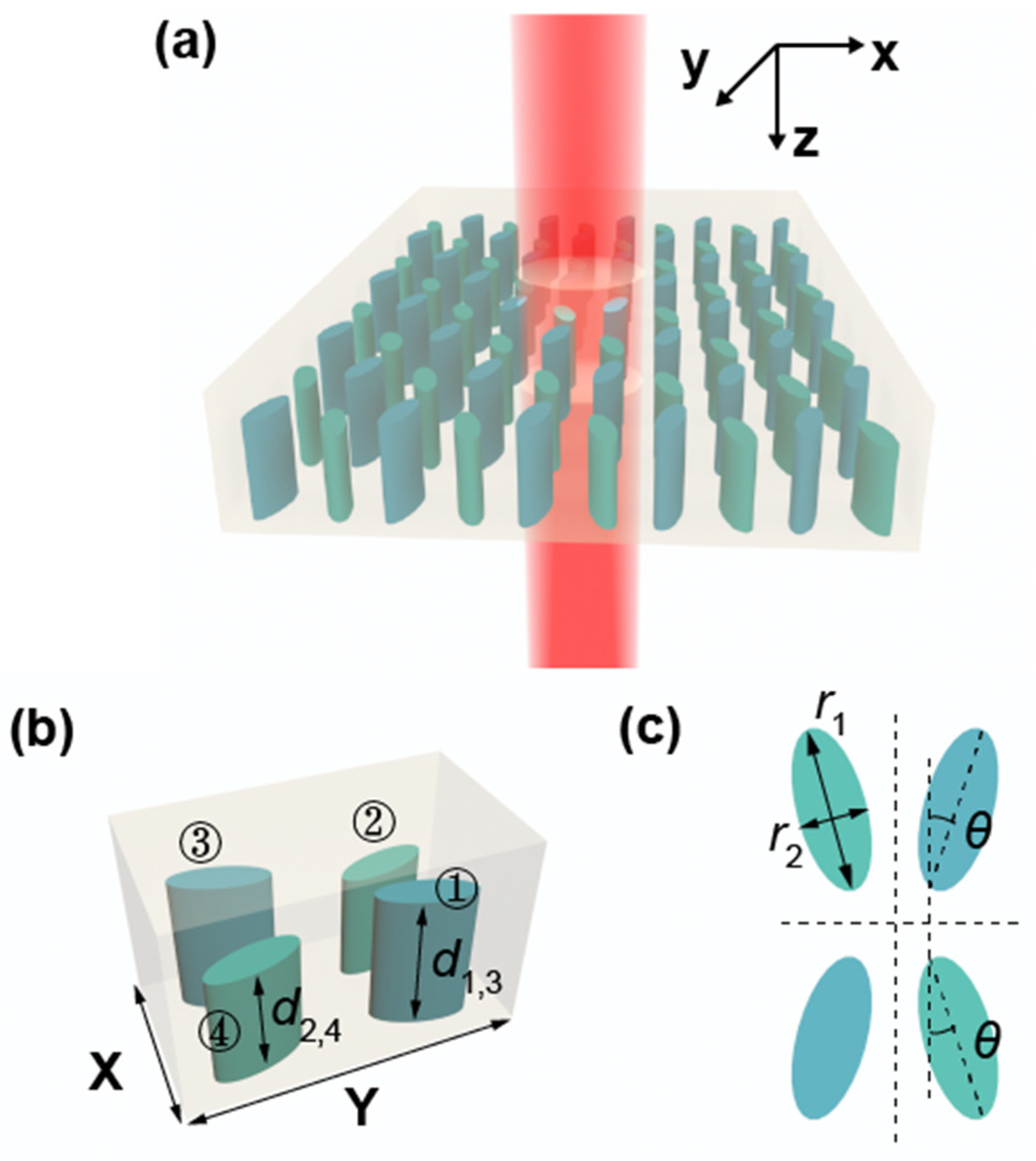
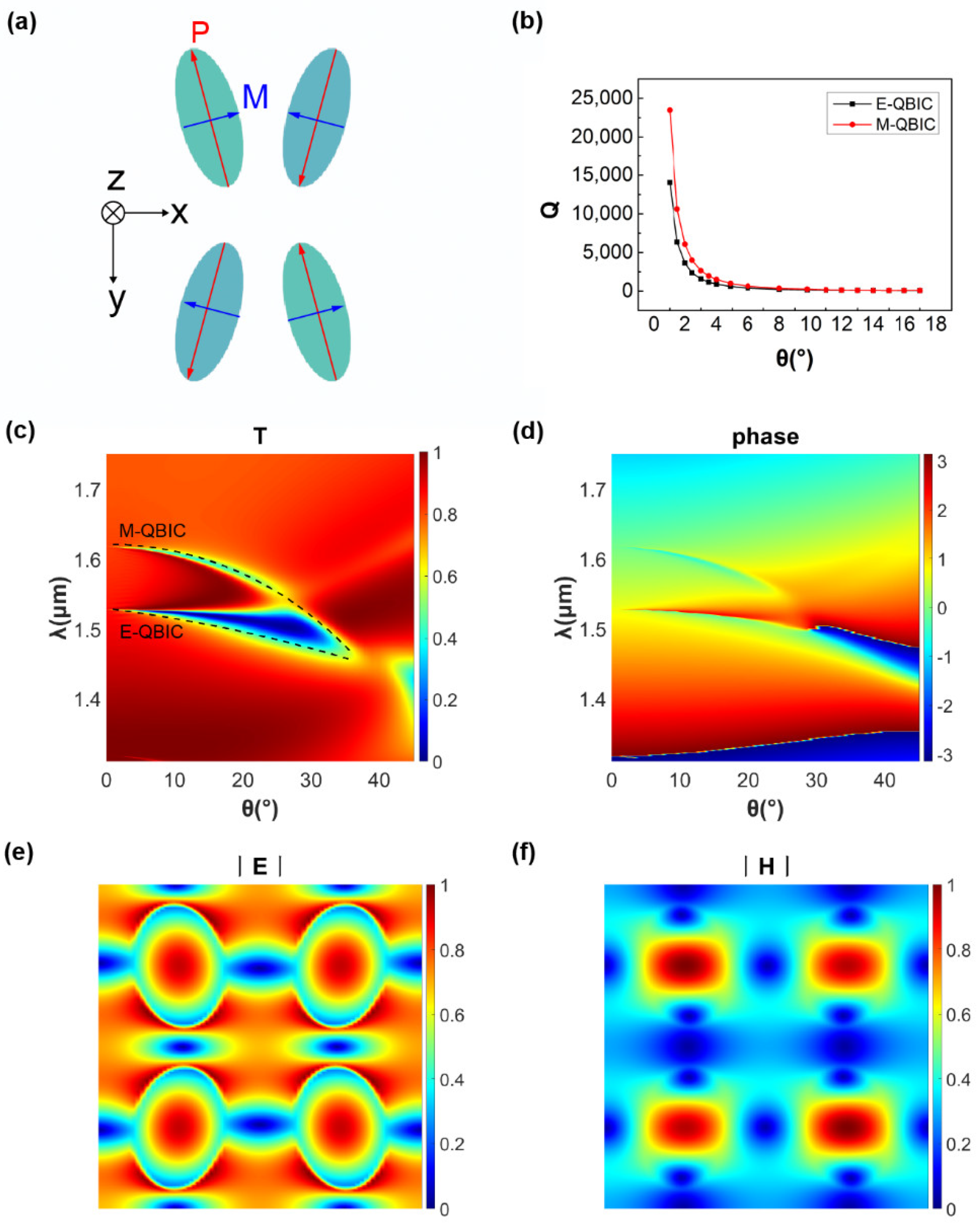
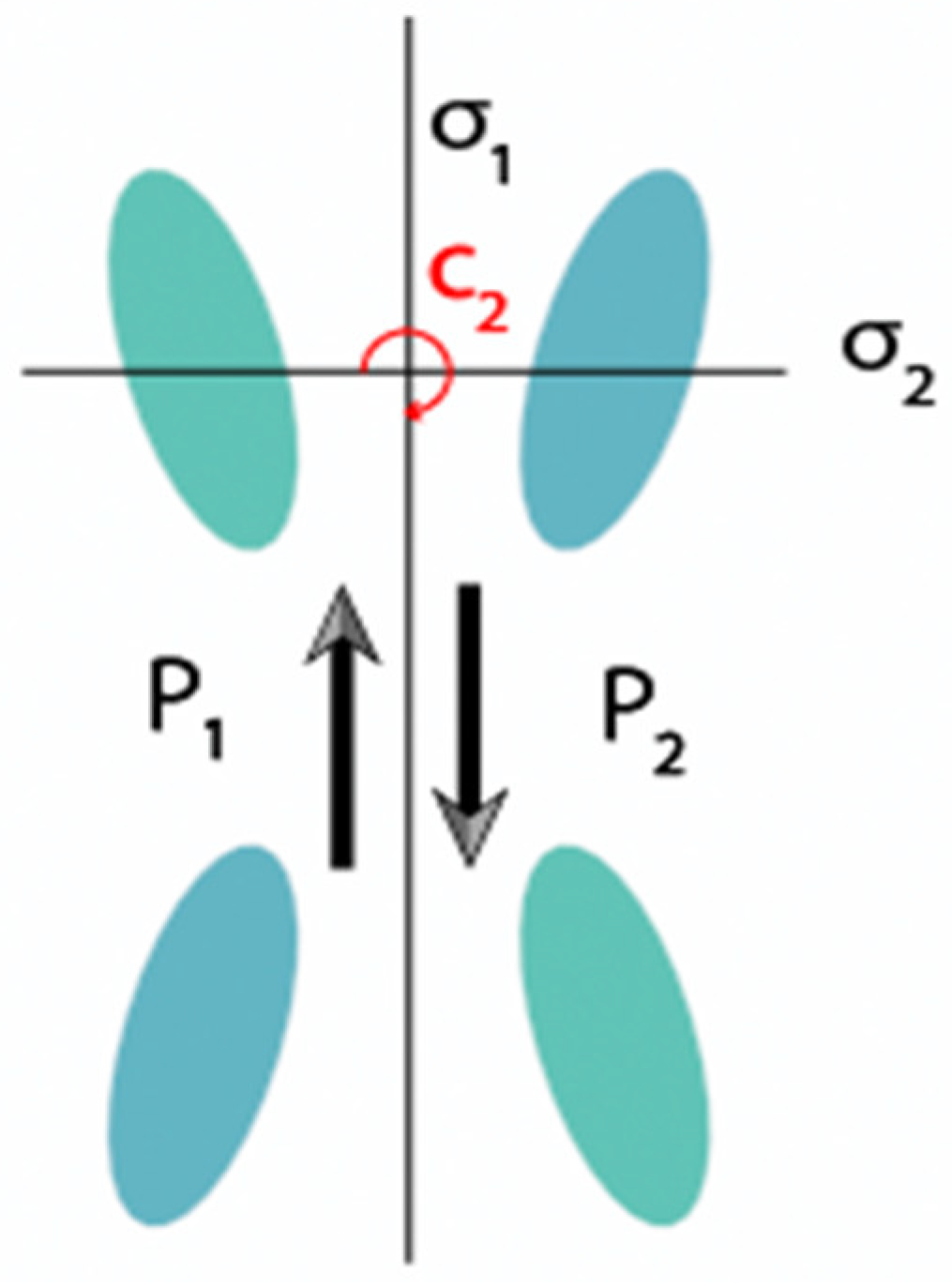
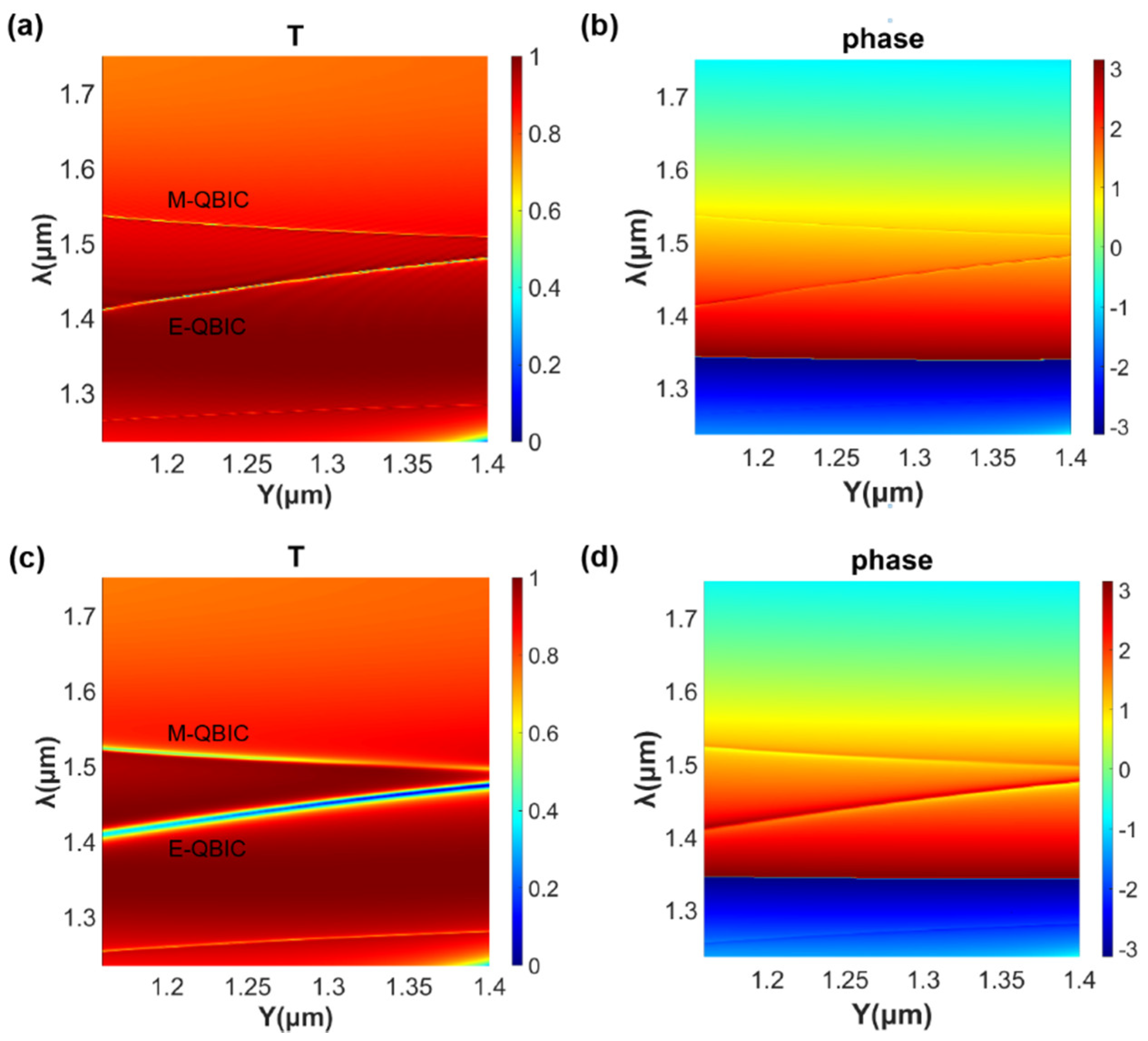
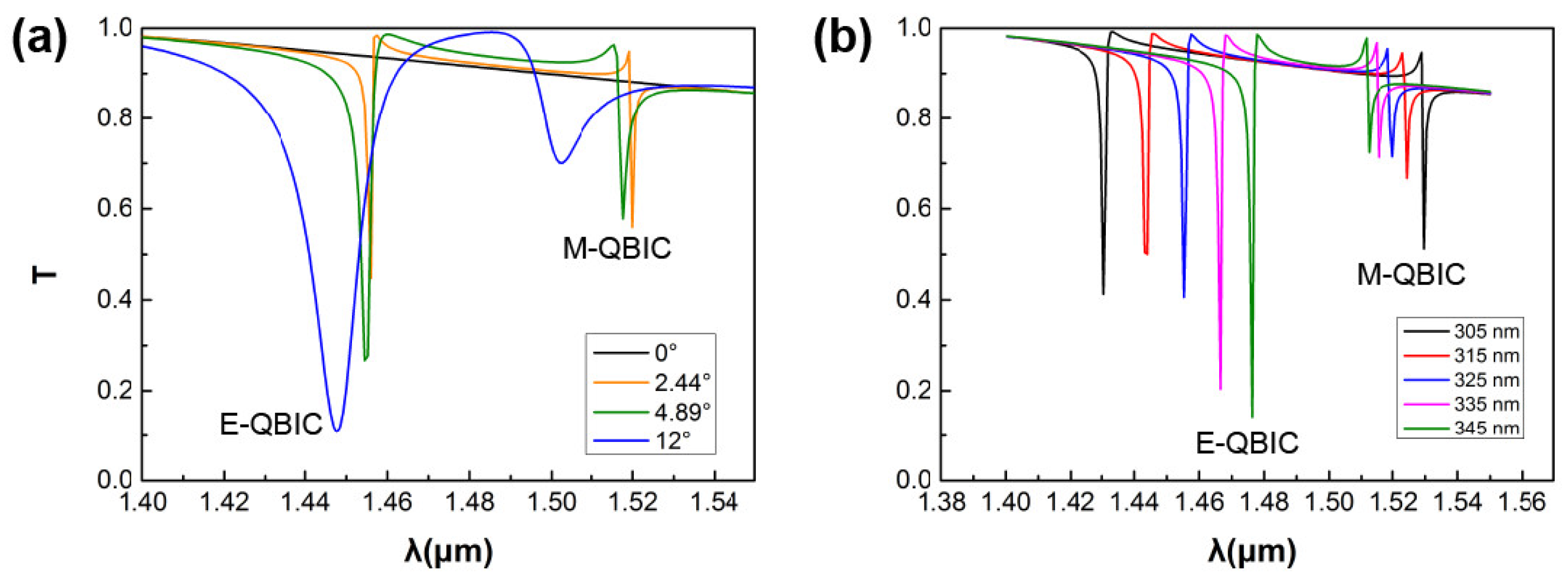

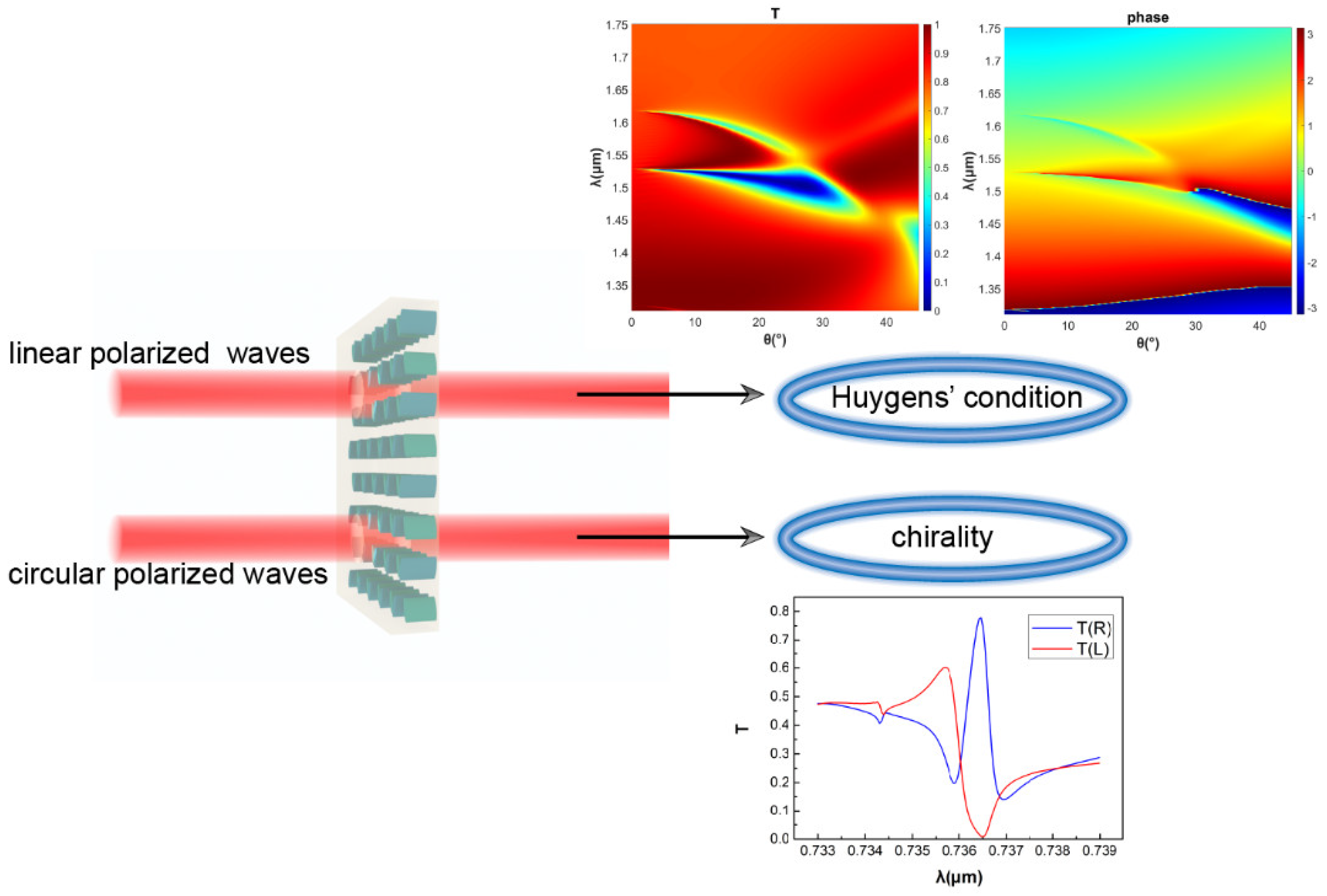
Publisher’s Note: MDPI stays neutral with regard to jurisdictional claims in published maps and institutional affiliations. |
© 2021 by the authors. Licensee MDPI, Basel, Switzerland. This article is an open access article distributed under the terms and conditions of the Creative Commons Attribution (CC BY) license (https://creativecommons.org/licenses/by/4.0/).
Share and Cite
Wang, J.; Liu, W.; Wei, Z.; Meng, H.; Liu, H.; Guo, J.; Yang, M.; Song, Y.; Xiang, L.; Huang, Z.; et al. A Bifunctional Silicon Dielectric Metasurface Based on Quasi-Bound States in the Continuum. Nanomaterials 2021, 11, 2357. https://doi.org/10.3390/nano11092357
Wang J, Liu W, Wei Z, Meng H, Liu H, Guo J, Yang M, Song Y, Xiang L, Huang Z, et al. A Bifunctional Silicon Dielectric Metasurface Based on Quasi-Bound States in the Continuum. Nanomaterials. 2021; 11(9):2357. https://doi.org/10.3390/nano11092357
Chicago/Turabian StyleWang, Jianan, Weici Liu, Zhongchao Wei, Hongyun Meng, Hongzhan Liu, Jianping Guo, Manxing Yang, Yongkang Song, Liujing Xiang, Zhenming Huang, and et al. 2021. "A Bifunctional Silicon Dielectric Metasurface Based on Quasi-Bound States in the Continuum" Nanomaterials 11, no. 9: 2357. https://doi.org/10.3390/nano11092357







